Biblical Spirituality
During my time in India I had already spent a considerable part of energy on helping to make Sacred Scripture accessible to ordinary Catholics. You will remember how catechetical lectures in Secunderabad grew out into creating a correspondence course, and later a book, entitled Background to the Gospels. I had also written the script for the illustrated Life of Christ that became part of the famous Amar Chitra Katha series. It had reached millions of people.
In early 1978 I passed through Rome. From its foundation I had been a member of the Catholic Biblical Federation, originally as the delegate for India. Its story can be found here: Access to God’s Word for all. So I paid a visit to my old friend, Fr Jos van de Valk, the secretary of the Federation, in his Roman offices. He told me that he was facing a catastrophe. A key speaker for the International Assembly of the Federation scheduled to take place in Malta just two months later had dropped out. “Please”, he pleaded with me. “Can you fill the gap?” I said: “Yes”.
I decided I would talk about ‘Biblical Spirituality’. What makes it different from, let us say, Franciscan spirituality or Ignatian spirituality? In record time I produced a quite original interpretation, even if I say so myself. After showing that all Christian spirituality has to be ‘biblical’ to a great extent, I highlighted four main elements: experience of God; searching the Scriptures; witness of the Spirit and transformation of life. The text can be read here: What is biblical spirituality?.
As luck would have it, the other key speaker at the Assembly was Prof Grech, an Italian expert on the Letters of St. Paul. In his broken English he tried to explain that the Greek word ‘pistis’ [= ‘faith’] has six slightly varying meanings in the Letter to the Romans. His speech was broken up in numerous points and paragraphs. Under meaning 3, fidelity, for instance, he said: “Well, here we have to note 9 points . . . Point one is this . . .” It may have been scholarly, but for this international audience of parish priests, students, religious sisters, college lecturers, etc. a total disaster. I looked at their faces. Some were asleep. Some bored. Some looked on in disbelief. When, after one and half hours the professor came to an end, everyone sighed with obvious relief.
So my lively and down-to-earth presentation after the break was a roaring success. For I had peppered my text with vivid examples from exciting persons: Basil the Great, Charles de Foucauld, Thérèse de Lisieux, Queen Bridget of Sweden, Francis of Assisi and others. When I finished, the response was overwhelming. My talk was published in at least nine international publications, with translations into Dutch, Chinese and other local languages.
Charismatics
Another major opportunity to promote familiarity with Sacred Scripture among Catholics arose in 1984. At that time charismatic renewal groups had sprung up all over the world. My first encounter with charismatics in India some fifteen years earlier had left me sceptical. I was not convinced by the charismatics’ uncontrolled ‘speaking in tongues’ or their glib assertion of miracles. But gradually I changed my mind. I realised that a direct, almost tangible, experience of God’s Spirit is actually healthy in a Christian’s life. Moreover, I had come across cases where a ‘baptism by the Spirit’ had in fact liberated some persons from deep psychological traumas.
As it happened I knew some of the charismatic movement’s top brass, such as Mr Piet Derksen of Getuigenis van Gods Liefde in the Netherlands. Then, previously, I had got to know Fr Fio Mascarenhas SJ and Fr Gino Henriques CSSR, national leaders of the Charismatic Renewal in India. In England I was in touch with the local chairman, Chris Whitehead. I do not remember the exact channel, but somehow I was invited to speak about Scripture studies to the International Charismatic Convention that took place in Rome from the 30th of April to the 5th of May 1984.
It was a huge event. Hundreds of participants from all over the world, mainly leaders of prayer groups. My task was to explain to them how to make the reading of Scripture trustworthy and fruitful. This would require introducing an element of instruction. I presented the outline of a comprehensive ‘plan’ which was later published as ‘Scripture in our Life’ in the charismatic manual, and in international magazines such as Word & Worship, Koinonia and Scripture Bulletin. It can be read online in an adapted form as ‘On Planning Scripture Studies’ in Priests & People.
I was only given one hour for my talk and discussion. I realised that I would not be able to do full justice to the subject during the convention itself, so I had prepared 4 diagrams and 30 pages of text which were distributed to all the participants. For the sake of interest I will print the four diagrams here. I apologise for their poor quality. Remember that at the time we had no computers. I had to part type part draw the diagrams on stencils which were then used to make copies.
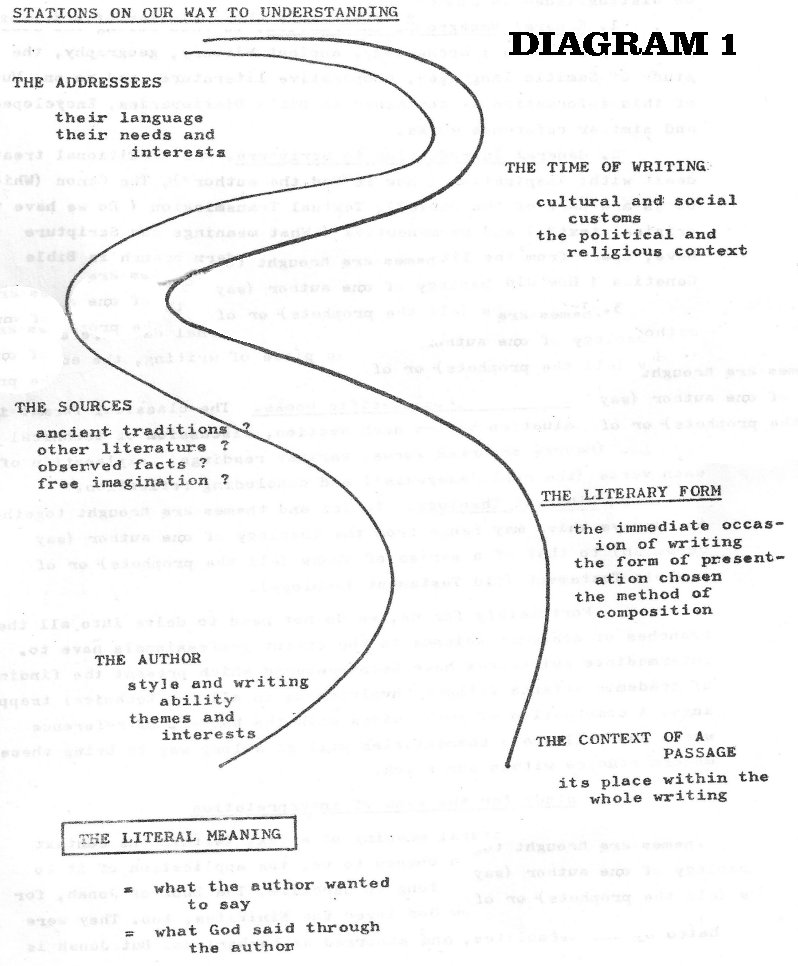
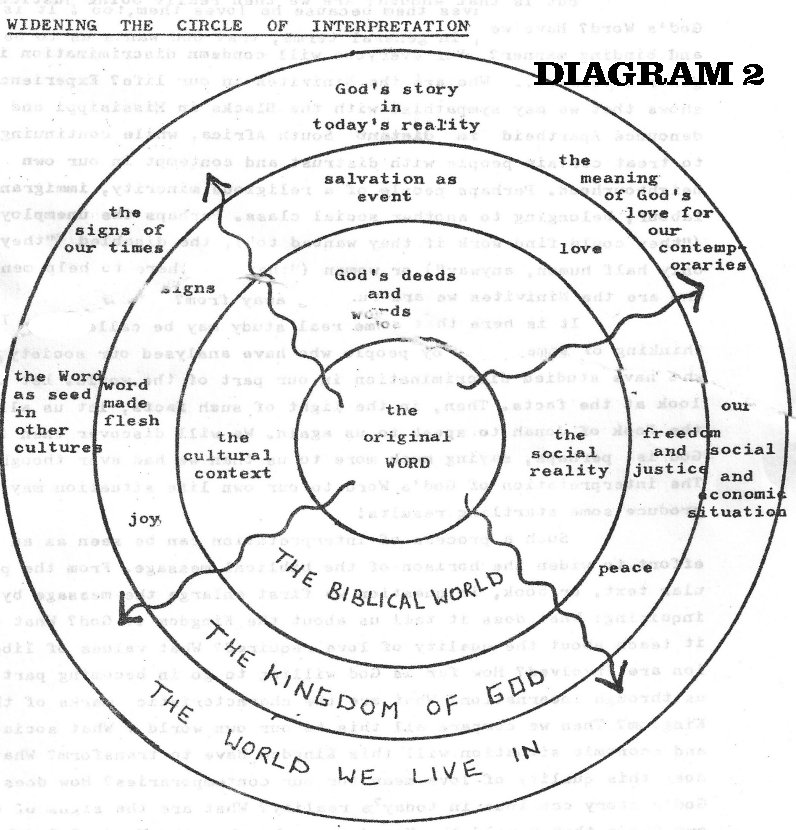
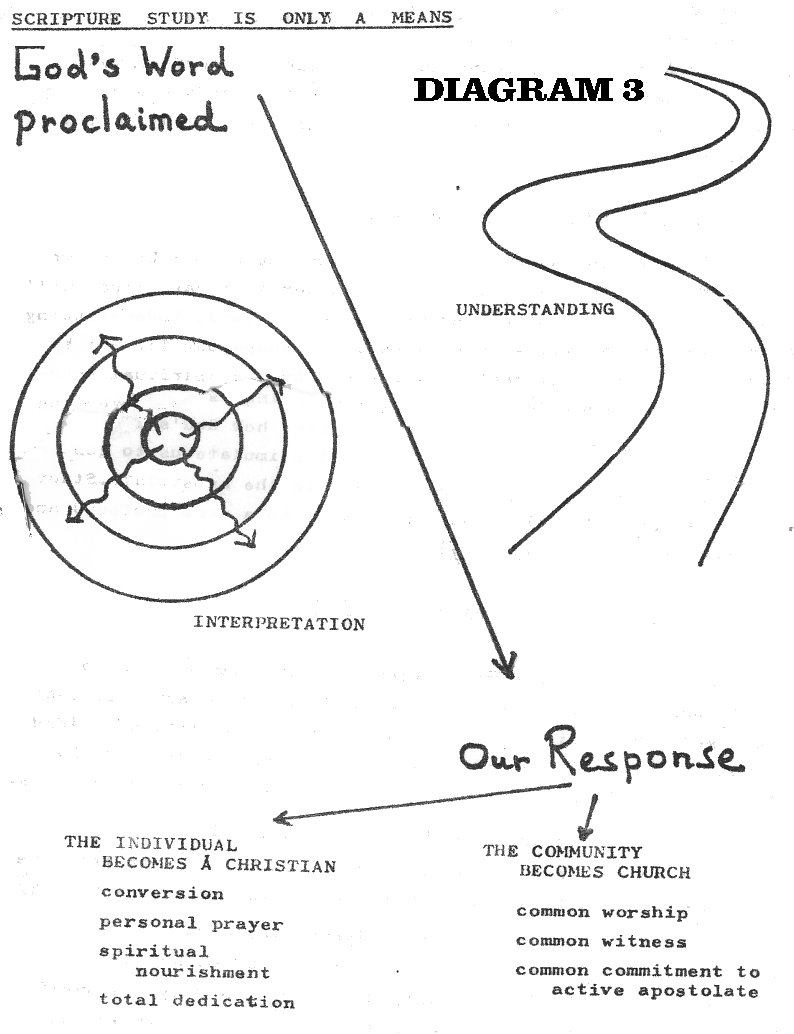
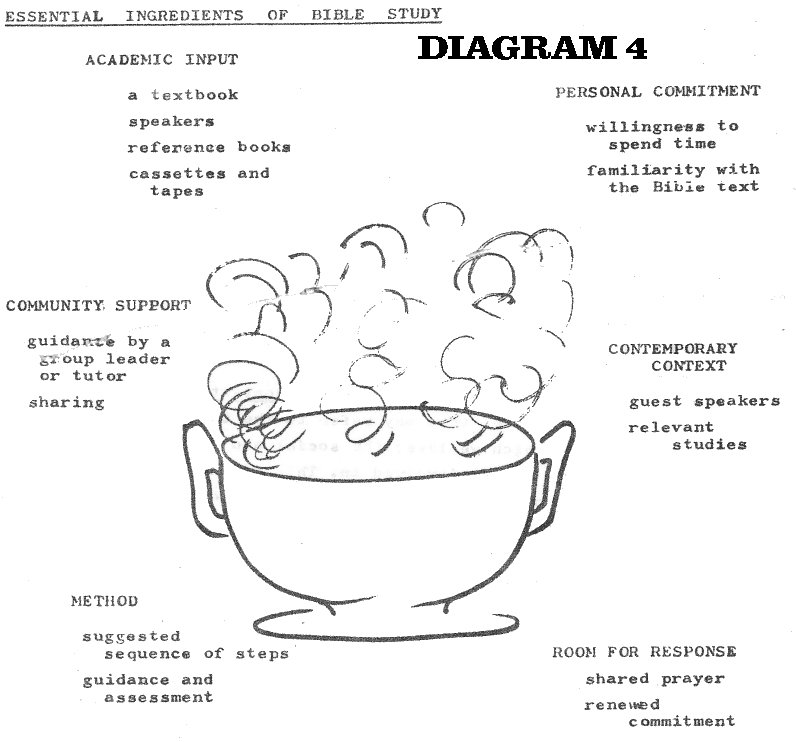
Courses turned into books
Listening to sermons, it had long struck me that most preachers did not really know how to make the biblical message relevant to their audiences. I myself had learned much from the imaginative biblical conferences of an American retreat preacher in Rome, and the spell-binding sermons of a parish priest in Nijmegen, the Netherlands. So I developed a course, both for the seminarians I was teaching in St John’s College, Hyderabad, and groups of priests being updated at the National Centre, Bangalore, and elsewhere. The course was quite creative and took most of my students by surprise.
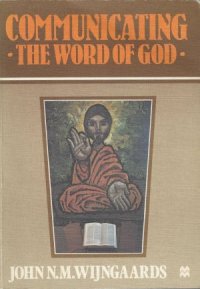 The first part of the course dealt with the whole purpose of Scripture to enlighten people’s lives. Its power through images and stories. Then I spelled out twelve different techniques. I explained how ‘simple free narration’ differs from the ‘story-reflection-story’ approach. I worked out how a biblical personality could be painted in a straightforward ‘portrait’ or brought to life with pertinent ruminations. I presented how scriptural ‘motifs’ and ‘themes’ could be used in sermons. Other categories included imaginative elaboration, meditating on a law, unravelling a proverb, giving witness or speaking a prophecy. Whenever I taught this course, I made my students play out the various techniques. It helped to bring out what could, and what could not, be done.
The first part of the course dealt with the whole purpose of Scripture to enlighten people’s lives. Its power through images and stories. Then I spelled out twelve different techniques. I explained how ‘simple free narration’ differs from the ‘story-reflection-story’ approach. I worked out how a biblical personality could be painted in a straightforward ‘portrait’ or brought to life with pertinent ruminations. I presented how scriptural ‘motifs’ and ‘themes’ could be used in sermons. Other categories included imaginative elaboration, meditating on a law, unravelling a proverb, giving witness or speaking a prophecy. Whenever I taught this course, I made my students play out the various techniques. It helped to bring out what could, and what could not, be done.
When I turned the course into book form under the title “Communicating the Word of God”, its English edition was published both in the UK and in India. This was followed by publications in French (Paris 1982), Chinese (Hongkong 1985) and Spanish (Estella 1988). The book can be read online here.
 Another practical course I developed aimed at making readers in church present the scripture readings as effectively as possible. In particular, I showed how it is often necessary to de-code difficult words, customs or the context. For instance, Matthew 9,18 reads: “While he was speaking to them, behold a ruler came in and knelt before him…” Who is speaking to whom? The context shows us. So a more intelligible, de-coded text reads: “While Jesus was speaking to the disciples of John the Baptist, a government official came in, etc.” The course contains also many other useful hints and suggestions.
Another practical course I developed aimed at making readers in church present the scripture readings as effectively as possible. In particular, I showed how it is often necessary to de-code difficult words, customs or the context. For instance, Matthew 9,18 reads: “While he was speaking to them, behold a ruler came in and knelt before him…” Who is speaking to whom? The context shows us. So a more intelligible, de-coded text reads: “While Jesus was speaking to the disciples of John the Baptist, a government official came in, etc.” The course contains also many other useful hints and suggestions.
As a book the course came out under the title: “Yes, read the Word to others, but make them understand”. Apart from the Indian and UK editions, a Dutch version was published in the Netherlands.
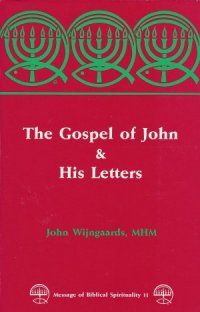 Then there was my course on St John’s Gospel which I taught on my lecture tours in India. I remember in particular a fruitful eight-day event for religious sisters in the catechetical centre of Patna, and a similar week-long exposition of John’s Gospel to religious leaders in Kisubi, Uganda. Instead of following a chapter-by-chapter approach, I highlighted the overpowering themes that pervade this Gospel. The first section (in six chapters) outlines the cosmic struggle between light and darkness. The second section (in eight chapters) paints the three revelations of divinity: Father, Son and Spirit. The third section (in six chapters) celebrates the overflowing of new life.
Then there was my course on St John’s Gospel which I taught on my lecture tours in India. I remember in particular a fruitful eight-day event for religious sisters in the catechetical centre of Patna, and a similar week-long exposition of John’s Gospel to religious leaders in Kisubi, Uganda. Instead of following a chapter-by-chapter approach, I highlighted the overpowering themes that pervade this Gospel. The first section (in six chapters) outlines the cosmic struggle between light and darkness. The second section (in eight chapters) paints the three revelations of divinity: Father, Son and Spirit. The third section (in six chapters) celebrates the overflowing of new life.
The course was published as a book by Michael Glazier in the USA (Wilmington 1986). It was followed by an Indian edition (Bangalore 1990) and a Philippino edition under the title ‘Living God’s Joy’ (Manila 1990). The book is available online here.
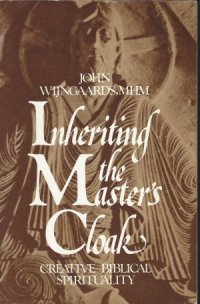 In my courses on the Old Testament, the greatest need was often to deal with violent, cruel, racist passages that are in conflict with the values of the God of Love we know through the New Testament. My course would first explain how the Old Testament narratives grew from oral traditions, with all their often raw and coarse content, into ever larger written texts. I would then apply a set of principles to distinguish between ‘primitive shell’ and ‘inspired teaching’. It resulted in ‘God’s Word to Israel’ that was published in India (Ranchi 1971).
In my courses on the Old Testament, the greatest need was often to deal with violent, cruel, racist passages that are in conflict with the values of the God of Love we know through the New Testament. My course would first explain how the Old Testament narratives grew from oral traditions, with all their often raw and coarse content, into ever larger written texts. I would then apply a set of principles to distinguish between ‘primitive shell’ and ‘inspired teaching’. It resulted in ‘God’s Word to Israel’ that was published in India (Ranchi 1971).
I also tried to show how to make creative use of OT narratives and reflections in sermons and conferences. The Old Testament contains, after all, 85% of Sacred Scripture. What we should do is take the ancient texts and examine them through the lense of our New Testament understanding. It often reveals deep insights and new dimensions of meaning. To see an example of this approach, read my article ‘Escape from the Cannibal God’.
To help people discover this approach, I published twenty worked out examples in ‘Inheriting the Master’s Cloak’ (Ave Maria Press 1985). Other editions followed in India (Bangalore 1986), the Philippines (Manila 1987) and Taiwan (Chinese translation, Taipei 1987). The book won a Catholic Press Association Award in the USA for ‘best adult spiritual reading’. The text can be found online here.
Jesus Christ
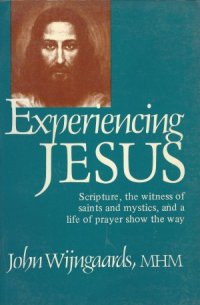 Jesus is, of course, the pivot around which all biblical spirituality turns. I have always been intrigued by Jesus’ promise at the Last Supper that he would return after his death and reveal himself to every true disciple. I do not have the space here to develop this at length. Just recall Jesus’ words: “I will come back to you . . . You will see me . . . Whoever keeps my commandment (of love) . . . I shall love that person and reveal myself to him/her . . . My Father shall love that person too. We shall come to him/her and make our dwelling place in him/her” (John 14,18-23).
Jesus is, of course, the pivot around which all biblical spirituality turns. I have always been intrigued by Jesus’ promise at the Last Supper that he would return after his death and reveal himself to every true disciple. I do not have the space here to develop this at length. Just recall Jesus’ words: “I will come back to you . . . You will see me . . . Whoever keeps my commandment (of love) . . . I shall love that person and reveal myself to him/her . . . My Father shall love that person too. We shall come to him/her and make our dwelling place in him/her” (John 14,18-23).
In ‘Experiencing Jesus’ (Ave Maria Press 1981) I elaborated the implications of this. I suggested how we can become aware of Jesus’ presence in us. I showed how saints came across the reality of Jesus in their lives in so many different ways: Symeon the new Theologian, Thérèse of Lisieux, Francis of Assisi, Charles de Foucauld, Teresa of Avila and Simone Weil. The book was a great success. The American edition, in two printings, sold 26,000 copies. The Indian edition (Bangalore 1981) 15,000 copies. Then there was a Philippino edition (Manila 1987), and translations into Chinese (Hongkong 1984) and Dutch (Antwerp 1991).
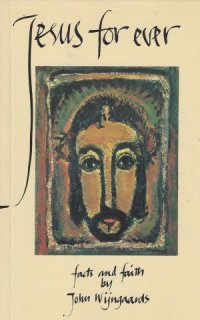 Some years later I faced another challenge also involving Jesus. The Catholic Truth Society in London asked me to respond to the accusation that we cannot trust the Gospel accounts, that we actually know very little about Jesus, that most of Jesus’ words and deeds are just myths.
Some years later I faced another challenge also involving Jesus. The Catholic Truth Society in London asked me to respond to the accusation that we cannot trust the Gospel accounts, that we actually know very little about Jesus, that most of Jesus’ words and deeds are just myths.
The booklet I wrote at their request, ‘Jesus for Ever. Facts and Faith’, reports the evidence we have on the historical reliability of the oral traditions underlying the Gospels. It sets out in detail how strong the testimonies are both inside and outside of the Gospels on Jesus rising again ‘on the Third Day’. It analyses Luke’s claim in his prologue to present a historical account of Jesus’ life, showing in particular how contemporary Hellenistic society was very conscious of the requirements of accurate historical reporting. But I also explain the difference with our present-day ‘photographic’ approach. The focus lay on reporting the substance, not on accidental details. And since Jesus’ life amounted to the divine dimension manifesting itself, it’s full significance can only be grasped by minds open to faith. The text can be read online here.
I also wrote extensively on Jesus and the Gospels in the ‘Walking on Water’ video series. I will report on this in a later chapter.
THE STORY OF MY LIFE
- » FOREWORD
- » Part One. LEARNING TO SURVIVE
- » origins
- » into gaping jaws
- » from the pincers of death
- » my father
- » my mother
- » my rules for survival
- » Part Two. SUBMIT TO CLERICAL DOGMA — OR THINK FOR MYSELF?
- » seeking love
- » learning to think
- » what kind of priest?
- » training for battle
- » clash of minds
- » lessons on the way to India
- » Part Three (1). INDIA - building 'church'
- » St John's Seminary Hyderabad
- » Andhra Pradesh
- » Jyotirmai – spreading light
- » Indian Liturgy
- » Sisters' Formation in Jeevan Jyothi
- » Helping the poor
- » Part Three (2). INDIA – creating media
- » Amruthavani
- » Background to the Gospels
- » Storytelling
- » Bible translation
- » Film on Christ: Karunamayudu
- » The illustrated life of Christ
- » Part Three (3). INDIA - redeeming 'body'
- » spotting the octopus
- » the challenge
- » screwed up sex guru
- » finding God in a partner?
- » my code for sex and love
- » Part Four. MILL HILL SOCIETY
- » My job at Mill Hill
- » The future of missionary societies
- » Recruitment and Formation
- » Returned Missionaries
- » Brothers and Associates
- » Part Five. HOUSETOP LONDON
- » Planning my work
- » Teaching teaching
- » Pakistan
- » Biblical Spirituality
- » Searching God in our modern world
- » ARK2 Christian Television
- » Part Five (2) New Religious Movements
- » Sects & Cults
- » Wisdom from the East?
- » Masters of Deception
- » Part Five (3). VIDEO COURSES
- » Faith formation through video
- » Our Spirituality Courses
- » Walking on Water
- » My Galilee My People
- » Together in My Name
- » I Have No Favourites
- » How to Make Sense of God
- » Part Six (1). RESIGNATION
- » Publicity
- » Preamble
- » Reaction in India
- » Mill Hill responses
- » The Vatican
- » Part 6 (2). JACKIE
- » childhood
- » youth and studies
- » finding God
- » Mission in India
- » Housetop apostolate
- » poetry
- » our marriage
